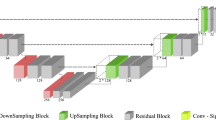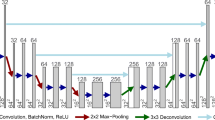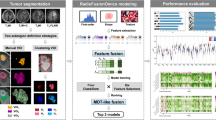Abstract
Purpose
The aim of this study was to develop a convolutional neural network (CNN) for the automatic detection and segmentation of gliomas using [18F]fluoroethyl-L-tyrosine ([18F]FET) PET.
Methods
Ninety-three patients (84 in-house/7 external) who underwent a 20–40-min static [18F]FET PET scan were retrospectively included. Lesions and background regions were defined by two nuclear medicine physicians using the MIM software, such that delineations by one expert reader served as ground truth for training and testing the CNN model, while delineations by the second expert reader were used to evaluate inter-reader agreement. A multi-label CNN was developed to segment the lesion and background region while a single-label CNN was implemented for a lesion-only segmentation. Lesion detectability was evaluated by classifying [18F]FET PET scans as negative when no tumor was segmented and vice versa, while segmentation performance was assessed using the dice similarity coefficient (DSC) and segmented tumor volume. The quantitative accuracy was evaluated using the maximal and mean tumor to mean background uptake ratio (TBRmax/TBRmean). CNN models were trained and tested by a threefold cross-validation (CV) using the in-house data, while the external data was used for an independent evaluation to assess the generalizability of the two CNN models.
Results
Based on the threefold CV, the multi-label CNN model achieved 88.9% sensitivity and 96.5% precision for discriminating between positive and negative [18F]FET PET scans compared to a 35.3% sensitivity and 83.1% precision obtained with the single-label CNN model. In addition, the multi-label CNN allowed an accurate estimation of the maximal/mean lesion and mean background uptake, resulting in an accurate TBRmax/TBRmean estimation compared to a semi-automatic approach. In terms of lesion segmentation, the multi-label CNN model (DSC = 74.6 ± 23.1%) demonstrated equal performance as the single-label CNN model (DSC = 73.7 ± 23.2%) with tumor volumes estimated by the single-label and multi-label model (22.9 ± 23.6 ml and 23.1 ± 24.3 ml, respectively) closely approximating the tumor volumes estimated by the expert reader (24.1 ± 24.4 ml). DSCs of both CNN models were in line with the DSCs by the second expert reader compared with the lesion segmentations by the first expert reader, while detection and segmentation performance of both CNN models as determined with the in-house data were confirmed by the independent evaluation using external data.
Conclusion
The proposed multi-label CNN model detected positive [18F]FET PET scans with high sensitivity and precision. Once detected, an accurate tumor segmentation and estimation of background activity was achieved resulting in an automatic and accurate TBRmax/TBRmean estimation, such that user interaction and potential inter-reader variability can be minimized.






Similar content being viewed by others
Abbreviations
- BGmean :
-
Mean background uptake
- CNN:
-
Convolutional neural network
- DSC:
-
Dice similarity coefficient
- 3D:
-
Three-dimensional
- [18F]FET :
-
[18F]fluoroethyl-L-tyrosine
- [18F]FDG:
-
[18F]fluoro-deoxy-glucose
- IDH1:
-
Isocitrate dehydrogenase 1
- LAT2:
-
L-type amino acid transporter 2
- Lesionmax :
-
Maximal lesion uptake
- MTV:
-
Metabolic tumor volume
- OSEM:
-
Ordered-subset expectation maximization
- PSF:
-
Point spread function modeling
- ReLU:
-
Rectified linear unit
- TAC:
-
Time activity curve
- TBR:
-
Tumor to background ratio
- TTM:
-
Total tumor metabolism
- TTP:
-
Time to peak
- U-Nettumor :
-
U-Net for tumor segmentation
- U-Nettumor ,BG :
-
U-Net for tumor and background segmentation
- VOI:
-
Volume of interest
References
Albert NL, Weller M, Suchorska B, Galldiks N, Soffietti R, Kim MM, et al. Response Assessment in Neuro-Oncology working group and European Association for Neuro-Oncology recommendations for the clinical use of PET imaging in gliomas. Neuro-Oncol. 2016;18(9):1199–208.
Galldiks N, Langen KJ, Pope WB. From the clinician’s point of view-what is the status quo of positron emission tomography in patients with brain tumors? Neuro Oncol. 2015;17(11):1434–44.
Kobayashi K, Ohnishi A, Promsuk J, Shimizu S, Kanai Y, Shiokawa Y, et al. Enhanced tumor growth elicited by L-type amino acid transporter 1 in human malignant glioma cells. Neurosurgery. 2008;62(2):493–504.
Stöber B, Tanase U, Herz M, Seidl C, Schwaiger M, Senekowitsch-Schmidtke R. Differentiation of tumour and inflammation: characterisation of [methyl-3H] methionine (MET) and O-(2-[18F]fluoroethyl)-L-tyrosine (FET) uptake in human tumour and inflammatory cells. Eur J Nucl Med Mol Imaging. 2006;33(8):932–9.
Lahoutte T, Caveliers V, Camargo SM, Franca R, Ramadan T, Veljkovic E, et al. SPECT and PET amino acid tracer influx via system L (h4F2hc-hLAT1) and its transstimulation. J Nucl Med. 2004;45(9):1591–6.
Verger A, Arbizu J, Law I. Role of amino-acid PET in high-grade gliomas: limitations and perspectives. Q J Nucl Med Mol Imaging. 2018;62(3):254–66.
Dunet V, Pomoni A, Hottinger A, Nicod-Lalonde M, Prior JO. Performance of [18F]FET versus [18F]FDG-PET for the diagnosis and grading of brain tumors: systematic review and meta-analysis. Neuro-Oncol. 2015;18(3):426–34.
Weckesser M, Langen KJ, Rickert CH, Kloska S, Straeter R, Hamacher K, et al. O-(2-[18F]fluorethyl)-L-tyrosine PET in the clinical evaluation of primary brain tumours. Eur J Nucl Med Mol Imaging. 2005;32(4):422–9.
Langen KJ, Stoffels G, Filss C, Heinzel A, Stegmayr C, Lohmann P, Willuweit A, Neumaier B, Mottaghy FM, Galldiks N. Imaging of amino acid transport in brain tumours: positron emission tomography with O-(2-[18F]fluoroethyl)-L-tyrosine (FET). Methods. 2017;1(130):124–34.
Ahmed R, Oborski MJ, Hwang M, Lieberman FS, Mountz JM. Malignant gliomas: current perspectives in diagnosis, treatment, and early response assessment using advanced quantitative imaging methods. Cancer management and research. 2014;6:149.
Weber DC, Zilli T, Buchegger F, Casanova N, Haller G, Rouzaud M, et al. [(18) F] Fluoroethyltyrosine-positron emission tomography-guided radiotherapy for high-grade glioma. Radiat Oncol. 2008;3(1):1–11.
Verma N, Cowperthwaite MC, Burnett MG, Markey MK. Differentiating tumor recurrence from treatment necrosis: a review of neuro-oncologic imaging strategies. Neuro Oncol. 2013;15(5):515–34.
Bolcaen J, Descamps B, Deblaere K, Boterberg T, Pharm FDV, Kalala JP, et al. 18F-fluoromethylcholine (FCho), 18F-fluoroethyltyrosine (FET), and 18F-fluorodeoxyglucose (FDG) for the discrimination between high-grade glioma and radiation necrosis in rats: a PET study. Nucl Med Biol. 2015;42(1):38–45.
Pöpperl G, Kreth FW, Mehrkens JH, Herms J, Seelos K, Koch W, et al. FET PET for the evaluation of untreated gliomas: correlation of FET uptake and uptake kinetics with tumour grading. Eur J Nucl Med Mol Imaging. 2007;34(12):1933–42.
Floeth FW, Pauleit D, Sabel M, Stoffels G, Reifenberger G, Riemenschneider MJ, et al. Prognostic value of O-(2–18F-fluoroethyl)-L-tyrosine PET and MRI in low-grade glioma. J Nucl Med. 2007;48(4):519–27.
Floeth FW, Sabel M, Stoffels G, Pauleit D, Hamacher K, Steiger HJ, et al. Prognostic value of 18F-fluoroethyl-L-tyrosine PET and MRI in small nonspecific incidental brain lesions. J Nucl Med. 2008;49(5):730–7.
Celli M, Caroli P, Amadori E, Arpa D, Gurrieri L, Ghigi G, et al. Diagnostic and prognostic potential of 18F-FET PET in the differential diagnosis of glioma recurrence and treatment-induced changes after chemoradiation therapy. Front Oncol. 2021;11:721–821.
Blanc-Durand P, Van Der Gucht A, Verger A, Langen KJ, Dunet V, Bloch J, et al. Voxel-based 18F-FET PET segmentation and automatic clustering of tumor voxels: a significant association with IDH1 mutation status and survival in patients with gliomas. PLoS ONE. 2018;13(6): e0199379.
Debus C, Waltenberger M, Floca R, Afshar-Oromieh A, Bougatf N, et al. Impact of 18F-FET PET on target volume definition and tumor progression of recurrent high grade glioma treated with carbon-ion radiotherapy. Sci Rep. 2018;8(1):1–13.
Andrearczyk V, Oreiller V, Boughdad S, Rest CCL, Elhalawani H, Jreige M, et al. Overview of the HECKTOR challenge at MICCAI 2021: automatic head and neck tumor segmentation and outcome prediction in PET/CT images. In 3D Head and Neck Tumor Segmentation in PET/CT Challenge. Springer Cham. 2021;1–37.
Hatt M, Laurent B, Ouahabi A, Fayad H, Tan S, Li L, et al. The first MICCAI challenge on PET tumor segmentation. Med Image Anal. 2018;44:177–95.
Blanc-Durand P, Van Der Gucht A, Schaefer N, Itti E, Prior JO. Automatic lesion detection and segmentation of 18F-FET PET in gliomas: a full 3D U-Net convolutional neural network study. PLoS ONE. 2018;13(4): e0195798.
Louis DN, Perry A, Wesseling P, Brat DJ, Cree IA, Figarella-Branger D, Hawkins C, Ng HK, Pfister SM, Reifenberger G, Soffietti R. The 2021 WHO classification of tumors of the central nervous system: a summary. Neuro Oncol. 2021;23(8):1231–51.
Unterrainer M, Vettermann F, Brendel M, Holzgreve A, Lifschitz M, Zähringer M, et al. Towards standardization of 18F-FET PET imaging: do we need a consistent method of background activity assessment? Eur J Nucl Med Mol Imaging Res. 2017;7(1):1–8.
Koopman T, Verburg N, Schuit RC, Pouwels PJ, Wesseling P, Windhorst AD, Hoekstra OS, de Witt Hamer PC, Lammertsma AA, Boellaard R, Yaqub M. Quantification of O-(2-[18F]fluoroethyl)-L-tyrosine kinetics in glioma. EJNMMI Res. 2018;8(1):1–9.
Çiçek Ö, Abdulkadir A, Lienkamp SS, Brox T, Ronneberger O. 3D U-Net: learning dense volumetric segmentation from sparse annotation. In International conference on medical image computing and computer-assisted intervention. Springer Cham. 2016; 424–32.
Isensee F, Jaeger PF, Kohl SA, Petersen J, Maier-Hein KH. nnU-Net: a self-configuring method for deep learning-based biomedical image segmentation. Nat Methods. 2021;18(2):203–11.
Rahimpour M, Bertels J, Radwan A, Vandermeulen H, Sunaert S, Vandermeulen D, Maes F, Goffin K, Koole M. Cross-modal distillation to improve MRI-based brain tumor segmentation with missing MRI sequences. IEEE Transactions on Biomedical Engineering. 2021 Dec 23.
Rahimpour M, Saint Martin MJ, Frouin F, Akl P, Orlhac F, Koole M, Malhaire C. Visual ensemble selection of deep convolutional neural networks for 3D segmentation of breast tumors on dynamic contrast enhanced MRI. Eur Radiol. 2022;8:1–1.
Rahimpour M, Radwan A, Vandermeulen H, Sunaert S, Goffin K, Koole M. Investigating certain choices of CNN configurations for brain lesion segmentation. arXiv preprint arXiv:2212.01235. Accessed 2 Dec 2022.
Rahimpour M, Boellaard R, Deckers W, Goffin K, Koole M. Kinetic filtering and deep learning for the automatic detection and quantification of primary brain tumors using dynamic 18F-FET PET imaging. InEuropean Association of Nuclear Medicine, Location: Barcelona, Spain 2022 Sep 1.
Lee YS, Kim JS, Kim KM, Kang JH, Lim SM, Kim HJ. Performance measurement of PSF modeling reconstruction (true X) on Siemens Biograph TruePoint TrueV PET/CT. Ann Nucl Med. 2014;28(4):340–8.
Rapp M, Heinzel A, Galldiks N, Stoffels G, Felsberg J, Ewelt C, et al. Diagnostic performance of 18F-FET PET in newly diagnosed cerebral lesions suggestive of glioma. J Nucl Med. 2013;54(2):229–35.
Acknowledgements
The authors would like to thank NVIDIA Corporation for donating a Titan X GPU.
Funding
This work was supported by the European Union’s Horizon 2020 Research and Innovation Programme under the Marie Sklodowska-Curie Grant 764458. The resources and services used in this work were provided by the VSC (Flemish Supercomputer Center), funded by the Research Foundation—Flanders (FWO) and the Flemish Government.
Author information
Authors and Affiliations
Corresponding author
Ethics declarations
Ethical approval
The study was approved by the local research ethics committee of UZ/KU Leuven (EC Research – study number: S63157). The external data are from the study on quantifying [18F]FET PET kinetics in gliomas (registered in the Netherlands National Trial Register (www.trialregister.nl), unique identifier NTR5354, registration date 4th of August 2015).
Conflict of interest
The authors declare no competing interests.
Additional information
Publisher's note
Springer Nature remains neutral with regard to jurisdictional claims in published maps and institutional affiliations.
This article is part of the Topical Collection on Advanced Image Analyses (Radiomics and Artificial Intelligence)
Supplementary Information
Below is the link to the electronic supplementary material.
Rights and permissions
Springer Nature or its licensor (e.g. a society or other partner) holds exclusive rights to this article under a publishing agreement with the author(s) or other rightsholder(s); author self-archiving of the accepted manuscript version of this article is solely governed by the terms of such publishing agreement and applicable law.
About this article
Cite this article
Rahimpour, M., Boellaard, R., Jentjens, S. et al. A multi-label CNN model for the automatic detection and segmentation of gliomas using [18F]FET PET imaging. Eur J Nucl Med Mol Imaging 50, 2441–2452 (2023). https://doi.org/10.1007/s00259-023-06193-5
Received:
Accepted:
Published:
Issue Date:
DOI: https://doi.org/10.1007/s00259-023-06193-5




